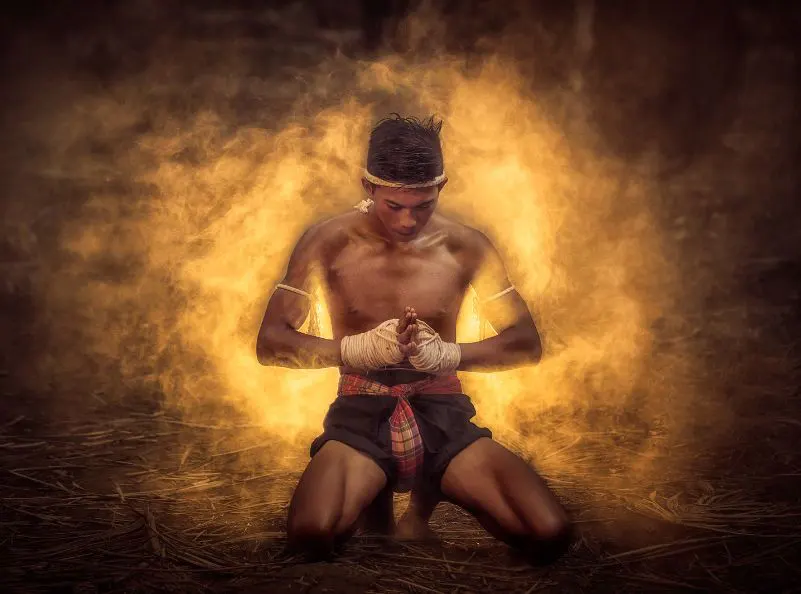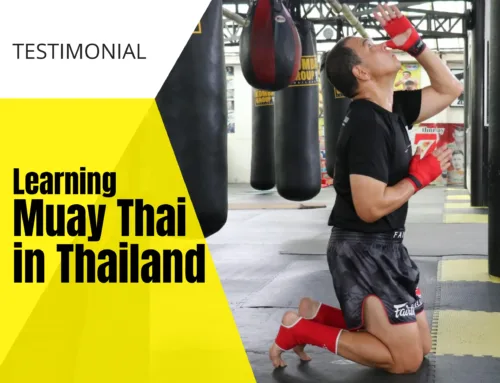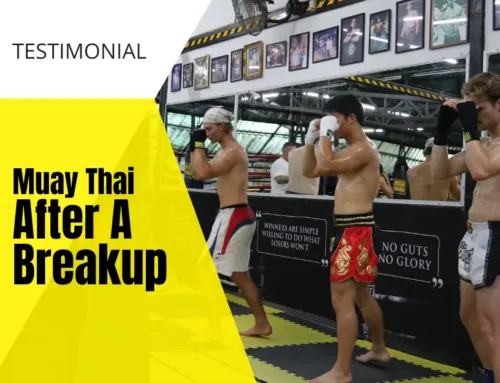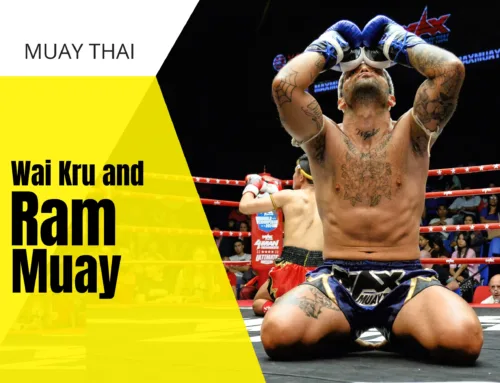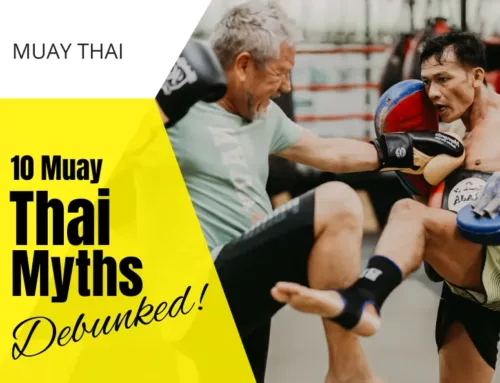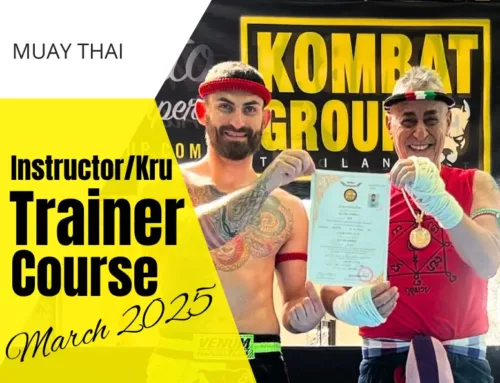Muay Thai or Thai boxing is the cultural martial art of Thailand. The origin of Muay Thai dates back several hundred years, and was, essentially, developed as a form of close-combat that used the entire body as a weapon.However, it must be added that the history of Muay Thai, and its’ direct origin is a question of debate among modern scholars. Much of the Muay Thai history was lost when the Burmese sacked Ayudhaya, the capital city of Siam (Thailand) in the 14th century. The Burmese looted the temples and depositories of knowledge held in the capital, and most written history was lost in this period. What volumes were saved are preserved and protected as national treasures for Thai culture and heritage.
What is known is that Muay Thai uses the body to mimic the weapons of war. The hands become the sword and dagger; the shins and forearms were hardened in training to act as armor against blows, and the elbow to fell opponents like a heavy mace or hammer; the legs and knees became the axe and staff. The body operated as one unit. The knees and elbows constantly searching and testing for an opening while grappling and trying to spin an enemy to the ground for the kill.
Origin of Muay Thai
The origin of Muay Thai, as a fighting style, is thought to have developed for centuries as tribes migrated south from the steppes of China through Vietnam, Laos, Burma, and Cambodia. The major tribes of that period, one of which was the (Tai) Siamese, fought fiercely to survive as they moved south and encountered other smaller tribes in what is now northern and central Thailand, and as far south as Malaysia. Through training, loss of life, military tactics, and hand-to-hand combat, technique and tactics were honed to a razors edge, and the rudimentary elements of a “fighting-style” began to take root.
Older soldiers and fathers taught their students and sons the offensive and defensive tactics and techniques, proper posture and position, and skills to enhance awareness. Those students and sons went on to teach their children, and the roots and permanent structure of an “effective fighting-style” began to strengthen. Proper technique and power strikes were a vital element in war that requires hand-to-hand skills. Each strike and movement is meant to deliever a debilitating and crushing blow, and enable the fighter to move on to the next opponent quickly without leaving himself exposed to an attack.
It would seem that the evolution of the most-effective hand-to-hand form of combat evolved in a rather Darwin-like manner demanding survival of the fittest: those who fought well…….lived and taught others before falling themselves.
The Thai were on constant guard against attack from neighboring countries, including Burma and Cambodia. Enemies for centuries, the Burmese and Thai fought several wars wreaking destruction on both countries. Muay Thai was primarily a part of the Thai culture during this period and was a mandatory training as part of the Thai military of that time. The military continued to train soldiers for centuries in the art of Muay Thai: defining, and refining the skills, tactics, and techniques with the wars against the Burmese, Cambodians, and other invaders.
Young Thai men returning from a tour of duty with the military soon engaged in matches for sport and fun in villages and towns. Each province, town, and village would support a local fighter who showed some promise and skill. Older warriors, survivors of many battles and engagements of the enemy, became Muay Thai instructors and teachers [ Kroo Muay]. The love of the sport, and a need for the defense of the kingdom made Muay Thai a part of the Thai culture for the next 500 years as generation after generation passed the skills on to the next.
Wai Kru/Ram Muay
The tradition of the Wai Kroo dates back several centuries. The Wai Kroo is a ritualistic and traditional dance carried out before Muay Thai fighters engage in the ring. The Wai Kroo is meant to show honor to the fighters teacher, the sport of Muay Thai, and his country. The Ram Muay is the dance that is unique to each Master instructor who teaches his students. The student will dance in each direction of the ring approaching and touching the corner posts with a prayer, showing respect to his opponent and to the spirits.
Modern Muay Thai
Muay Thai has come a long way in the last 100 years. Because of the great national popularity, Muay Thai began to garner international exposure and recognition. In World War II, Thai soldiers were stationed overseas, and foreigners recieved their first good look at Muay Thai firsthand. Muay Thai was named by foreigners as Siam Boxing, as Thailand was formerly Siam. During WW II, the French labeled Muay Thai as “Le Sport Orient” or the fighting style of the orient. The Thai soldiers participating in the war would practice Muay Thai among themselves as soldiers from Europe and America watched with great interest. Until that time, Muay Thai was a cultural gem, hidden within this strange and wonderful culture of this country called Thailand.
Soldiers from abroad were so impressed of the Muay Thai fighting style that they asked the Thai soldiers to teach them the basics and traditions of Muay Thai. As Muay Thai became more popular, especially with an international interest, the rules began to changge to become more inline with other goverened sports like boxing. In the 1920’s, the roots of modern Muay Thai were planted when rings were introduced replacing open courtyards.The old-style horsehide, hemp rope, or leather bindings were replaced with gloves similar to boxing. In the past, fighters were known to soak their hemp rope bindings in a sticky resin and then dip their hands in crushed glass and ash that could attack the opponents eyesight. [As appeared in the movie “Kickboxer” starring Jean-Claude Van Dame] A hard-cover groin protector was also added for the fighters protection from brutal kicks and knees.
After the end of WW II, the first formal rules were introduced into the sport. Fights were divided into 5 rounds, and time limits were imposed on each round. Time was counted on a clock rather than the old style of a coconut shell with holes sinking completely in a barrel of water. Major stadiums for Muay Thai were constructed after the war in large cities [Bangkok, Sukothai, Chiang Mai] throughout the country as the popularity of Muay Thai grew. Lumpini Stadium in Bangkok is now almost considered “holy ground” to the multitudes of Thai fighters, and now many foreigners, trying to win a place on a fight card. A system of weight-classes, defined rules, and championships was devised in the years ahead as Muay Thai began to resemble boxing in style and organization.
The typical Muay Thai fighter here in Thailand trains many hours everyday. Many fighters will fight every 3-4 weeks just to be able to support their family. Unlike boxing in Europe and America, Muay Thai fighters make very little money from each fight. A typical Muay Thai fighter may bring home 4000-6000 baht ($100 – $150) every month from fighting which is barely enough to support one person, much less a family.
Muay Thai fighters often begin training when they are 6-8 years-old. They will begin fighting between 8-10 years of age and may have as many as 120-150 fights ( 3 times as many as a very active boxer ) before they are 24 years old. Muay Thai fighters do not generally have long careers because of starting at such an early age and how physically demanding the sport is on the fighters. Injuries are quite common in Muay Thai fights. From cuts and lacerations to the face and head to broken bones and severe sprains of muscles and ligaments, Muay Thai fighters deal with injuries their entire career. Muay Thai fighters are known for their ability to ignore pain and injury.
Today, the evolution of Muay Thai is finally reaping rewards and recognition. Muay Thai was recently accepted as an Olympic sport, and it is becoming quite popular in many countries throughout the world. Professional fighters in martial arts, K-1, and submission fighting all agree, Muay Thai is an essential part of being an all-around skilled fighter and having stand-up fighting skills. Muay Thai will continue to grow in popularity as new training camps and gyms open around the world.
Muay Thai or Thai Boxing History.
King Naruesan
Thai history recounts the legend of King Naruesan. In 1560, during one of the many wars with the Burmese, the King was captured. Known for prowess and skills as a fighter, King Naruesan was offered a chance at freedom if he could defeat some of the best Burmese warriors. King Naruesan defeated all the Burmese warriors the King placed before him. He was granted his freedom and returned home a hero and a legend of Muay Thai.
The Thai people hearing of the heroics and skill at Muay Thai by their King led to great rise in the popularity of the sport. The tale of Naruesan fighting for his country and freedom spawned great enthusiasm and interest in the sport.
Nai Khanom Tom
The Father of Muay Thai.
Another quite popular Thai legend is that of Nai Khanom Tom and lends truth to the ability of highly skilled Muay Thai fighters. In 1767, the Burmese army sacked the Thai capital city of Ayudhaya (120 kilometers from Bangkok). The Burmese King (Lord Mangra) and his army pillaged the city and its its’ magnificient temples, treasure and wealth. Returning quickly to Burma before reinforcements arrived to save the capital, the Burmese army took prisoners for the long march back home to carry their stolen goods and treasures. Among those prisoners was a Muay Thai fighter named Nai Khanom Tom.To celebrate his victory over the Thai, the King of Burma held a festival and celebration. During the festival, the slaves from Thailand were ordered to fight the best Burmese fighters for entertainment.
When Nai Khanom Tom entered the courtyard to fight, he asked for a moment to prepare. Nai Khanom Tom then began a slow ritualistic dance around the courtyard waving his hands and arms. The Burmese fighter looked on in fear, as he thought Nai Khanom Tom was trying to curse him with evil spirits before they fought. When asked what he was doing, Nai Khanom Tom explained he was giving respect to his Muay Thai teacher, his sport, and his country by performing his short dance. Many believe this may have been the origins of the [Wai Kroo] which is still performed by all Thai fighters before they fight an opponent.
When the fight began, Nai Khanom Tom easily dispatched the Burmese fighter with a series of hard kicks and elbows. The Burmese fighter pleaded that he had lost because he was cursed by the Thai. However, Nai Khanom Tom went on to defeat 10 more Burmese rivals with combinations of hard, chopping, debilitating kicks and elbows, fast punches, and throwing his opponents to the ground. The Burmese King was impressed with Nai Khanom Tom’s ability and skill in the face of danger. When Nai Khanom Tom defeated his last rival, the Burmese King granted Nai Khanom Tom his freedom and rewarded him with several Burmese women to be his wives and concubines. Nai Khanom Tom returned to Thailand as a hero, and lived out his life teaching Muay Thai. Because the legend of Nai Khanom Tom is so well-known, he is called the “father of Muay Thai.” Muay Thai day is celebrated on March 16 in his honor.
The French Brothers
In 1788, during the reign of Rama I, two brothers from France traveled throughout S.E. Asia to study, wager, and fight against the different styles of combat they would encounter from the foreign tribes and counties, and peoples of the region. The brothers arrived in Thailand and arranged a match for prestige and money with the monarchy of the period. The Frenchmen were loud, and bragging of their victories in many different countries. The Thai King ordered his captain of the palace guard, a well respected Thai fighter, to fight one of the brothers for the honor of his country and sport, and a large sum of money was wagered on the fight.
When the fight began, the Thai danced around the fighting area moving quickly in and out of the reach of the French fighter and kept him at a distance by kicking him in the abdomen and legs. The Frenchman became enraged and angry he could not hit his Thai opponent. The Frenchman was not used to this style that used the entire body as a weapon. The other brother, watching from the side, decided to cheat and help his brother by grabbing the Thai from behind and pushing him within the reach of his brother’s attacks. This angered the Thai fighters and audience, and violated the spirit and rules of Muay Thai. The two Frenchman suddenly found themselves in trouble as the Thai fighters grappled and tackled the brothers to the ground until they were so exhausted and in pain that they could not rise. The two French brothers left the next day in defeat and humiliation. The popularity of Muay Thai continued to grow as did the national pride of the Thai people for their martial art.
Muay Thai: The Sport of Kings
The Tiger King of Thailand
Muay Thai is called “The Sport of Kings,” and the Thai monarchy has always played a promonent role in the development of the art and sport. King Sri Saan Petch, aka “The Tiger King,” was infamous for disguising himself in a tiger mask and competeing in tournaments. The King so loved the sport and a fair fight, that he would hide his royal heritage under a mask to compete in Muay Thai tournaments at festivals, fairs, and temple matches. If the other Thai fighters would have known it was their King, they would have bowed before him and pleaded not to fight; so great was their love and respect for their King. (The modern Thai people also hold the King in great reverence.) But the King hid his identity, and he always wanted a fair and hard fought match with each of his opponents.
The Thai Monarchy has played a central role in the devolpment of Muay Thai as a sport and not just a military requirement. Kings would hold great week long festivals in major cities that had spectacular Muay Thai tournaments with fighters traveling from all parts of the country to participate. In the early 1900’s, the sport started to become more centralized and marketable as an attraction. Sometimes, issues of national agenda, where high-ranking members of the Thai governement would disagree, the dispute would be settled by Muay Thai combat with each faction having a fighter to represent their interests.
Superstition, Tattoos, and Evil Spirits
The Thai people are known for being superstitious and their belief in evil spirits and ghosts. Muay Thai fighters have for centuries used special tattoos, wards, amulets, and ceremonies to increase their good fortune and ward off bad luck and evil spirits that might follow them into the ring. Fighters will often wear pieces of bones from their ancestors wrapped within their headdress [Mongkong] or in a armlet tied about the bicep. The bone is supposed to represent the good spirits of their ancestors and provide them protection from injury in the ring and evil spirits.
Some fighters, and regular Thai people, will often go the temple or a [Maa Doo], a witchdoctor/medicine man, or high-ranking priest to have tattoo inscriptions in Thai language etched into their skin. The powerful inscriptions are supposed to provide special protection from certain influences like good fortune, bad luck, ghosts, spirits, etc. Other tattoos were told to grant strength, courage, long-life, or sexual prowess. Often before fights, fighters would rub special oils and mixtures or potions on their skin to make them oblivious to pain and invulnerable.
Special amulets (Kreung Rang)worn around the neck were also told to carry special magical powers. Amulets could contain written inscriptions with wards and protections rolled up in a small cylinder. Other amulets came from important temples and bore the image of Buddah or highly-reverred monks. Whatever the amulet, tattoo, oil, potion, or inscription, the result was to give the fighter confidence through his strong beliefs.
Initiation and entrance to Muay Thai
The Buddha was, and described himself as, both a student and teacher. The teacher is held in reverence and respect in Thailand. When young men want to enter into a gym and become Muay Thai fighters, they must first pay respect to their Muay Thai teacher (Kroo Muay) and give respect and honor to the gym where they will train. You jusy don’t decide to become a Muay Thai fighter. It is a way of life and long respected tradition in Thailand. The student must perform the Yok Kroo or Kuen Kroo.
Each Master Thai instructor has a different style or way to perform the Yok Kroo. There may be a significant initiation where the prospective student must spend time in meditation at a temple, or perform some ritualistic tasks. Students are usually expected to give some form of gift or offering, such as white linen cloth, flowers, joss sticks (incense), and some small monetary offfering.
On auspicious days, (Thai’s like Thursdays for good luck and prosperity) a picnic or gathering of fighters to welcome the new student to camp and eat together. The Master Thai instructor would then ask for a blessing for his new student and then place the traditional Mongkon on the student’s head and tie a armlet (Pra Jer) on his bicep.
The Proud History of Muay thai
Muay Thai has been a part of Thai Heritage & History for over 2000 years as with most objects and traditions from ancient times, there exist many different versions of the History of MUAYTHAI, but all sources agree that MUAYTHAI was the primary (and most effective) Self Defense used by Thai warriors on the battlefields of conflicts and wars that have occurred many times in the history of the nation now know as, Thailand.
The first know practice of MUAYTHAI as a “sport”, off and away from the heat and chaos of the battlefield, occurred in the 15TH century when loosely organized competitions started spourting up around the country. MUAYTHAI soon became the favoured pastime sport for people from all walks of life, with training camps being established all over the country. It must be remembered that though it was being practiced as a kind of spectator sport over the following centuries, it was not the kid of sport we are used to seeing in modern times. Muaythai was an extremely dangerous that often ended in injury and for competitors and participants. It wasn’t until 1930 that this began to change, when MUAYTHAI was officially codified, with regulations being created and introduced into the sporting world of the early 20TH Century as one of a safe ring sport.
MUAYTHAI has had many faces, as a popular ring sport, a Self Defense and a fitness program and as MUAYTHAI has become more and more popular organizations such as IFMA have been rightly commissioned and estabilished to regulate MUAYTHAI as a world sport.
Now, MUAYTHAI is established around the world as a fitness form (MUAY aerobic), as a ring sport (MuayThai) and as a form of self defense (Muay Boran). The circle of history has been closed and MUAYTHAI now belongs to World, making a new and proud world History.
LONG LIVE MUAYTHAI!
Wai Khru
“MUAY THAI” has been practiced by Thais for over 2000 years and it’s traditions have been passed down from Generation to Generation as with most ancient Self Defense. One of the oldest traditions is a dance called “RAM MUAY”, which every boxer perform before a fight.
Before every fight the boxer “seal the ring” by circling three times, after which they perform the “RAM MUAY”, showing respect to their opponents and opposing camps, as well as parents, teachers and whatever religions they may believe in. Many boxers will display their techniques in this warm up and it is the perfect opportunity to study opponents.
For some boxers the Ram Muay represents deep spiritual beliefs while for others it’s the perfect warm up before a fight to get the mind and body ready for competiton. The music is refereed to as “wong pee glong” and is played by four musicians, each with their own instruments, pi java (Javanese oboe), glong kaek (a pair of thai drums played by 2 musicians) and a ching (small Thai cymbals) – The songs are very specific, only played in MUAYTHAI.
Every boxer wears a traditional headband, called a “mongkon”, which dates from the beginning of MUAYTHAI history- it is believed to bring good luck to the competition. Many boxers also wear a “Prajiad” around their biceps, also a long tradition.
Let the competition begin!!!
Skills
Muay Thai considered by many the most exciting and dynamic ring sport around incorporates the use of all 8 “weapons” of the human body: the fists, knees, elbows and feet.
There are 5 judges sitting in for each fight in order to score both offensive and defensive point decisions. Bouts are divided into 4 rounds with 2 minutes per round/ 2-minute between rounds. Safety is the most important aspect of Muay Thai, therefore boxers must wear protective equipment, consisting of a head guard, mouth guard, chest guard, elbow guard, gloves, hand wraps, groin guard and shin guards. Every boxer must have a boxer’s book and a medical check-up before and after every fight. The weigh-in for each boxer must be done before a fight and there are 14 strict weight divisions.
Referees in Muay Thai have to meet strict criteria and undergo yearly retesting.
Muay Thai has brought athletes together from around the world regardless of race, culture or religion for friendly international contests. Friendship plays a big part in our sport, especially taking physical aspects in consideration; this is why it is part of our rules that boxers “Wai” and shake hands with opponents, opposite corner, and referees all departing as friends.
MUAYTHAI includes many aspects yet sands as a singular sport with a proud tradition and heritage, a long-lasting culture, with people practising the sport for fitness, health, self-confidence, and an overall way of life!
Kickboxing…
…refers to sport-fighting using kicks and punches and sometimes throws and bows representing a certain martial art or can be practiced for general fitness, or as a full-contact sport. In the full contact version of the sport the male boxers are bare chested, barefoot and wear boxing trunks. The female boxers sometimes wear a tank top and shorts. Kickboxing is sometimes practiced as an independent style, but in many cases kickboxing is just an event and set of rules of by which martial artists of other styles may compete openly. Typically kickboxing in many competitions is a standing fight sport and does not allow continuation of the fight once the fight has reached the ground, however some styles may still train in this component for example; sanshou especially in the military and police and so must be adapted for kickboxing tournaments as well as many Japanese martial arts. Kickboxing can be attributed to K series of fighting styles. There are different rules for different kinds of kick-boxing. One can start at any age, but until 18 years old, a helmet is strongly recommended.
Jan Plas, the Dutch kickboxer founded Mejiro Gym with some Muay Thai pioneers in Netherlands, 1978 after he learned kickboxing from Kenji Kurosaki in Japan. In addition, he also founded NKBB (The Dutch Kickboxing Association) which is the first kickboxing organization in Netherlands in 1978. The sport took off in the U.S. with the popularity and success of Bill “Superfoot” Wallace” in the 1970s.
Muay Thai Training in Thailand
Regardless of experience, everyone is welcome to try Muay Thai training in Thailand at Kombat Group Thailand.

